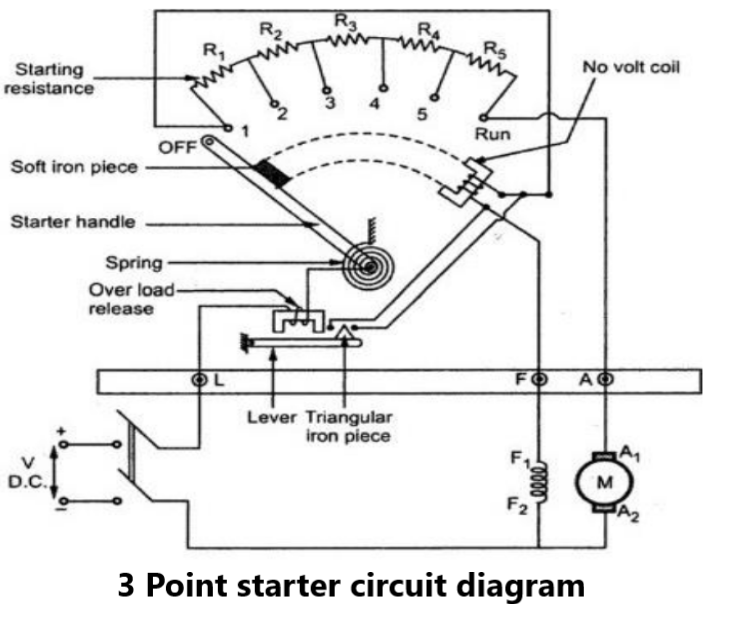Table of Contents
ToggleWhat is Three-point starter
A 3-point starter is an electrical device, used for starting as well as maintaining the DC shunt motor speed. The connection of resistance in this circuit is in series which decreases the initial high current and guards the equipment against any electrical failures. Here, the occurrence of back e.m.f plays an essential role in operating the motor. This emf extends when the armature of motor starts for rotating in the magnetic field by making the action as well as opposes the voltage supply.
Construction of 3-point starter
The DC motor based 3-point starter mainly includes three terminals namely L, A, and F. Here, L (line terminal) is connected to the positive supply, A (armature terminal) is connected to the windings of an armature terminal, and F (field terminal) is connected to the winding of field terminal.
The construction of 3-point starter includes a resistance ‘R’ for controlling the initial current. The “H’- handle in the circuit kept in the OFF condition with a spring ‘S’. The H-handle can be operated manually for motor operation. At the beginning of the motor position, the motor field winding gets the total supply voltage, & the armature current is restricted to the particular secure value by the resistance R.

Working of a Three-Point Starter
The handle of the 3-point starter can be moved from one stud to another stud (contact positions), and this increases the speed of the motor till gets the RUN position. There are three main points are considered in this position which includes the following.
The DC shunt motor gets the full speed
The voltage supply in the circuit is straight across both the motor’s windings.
The R-resistance is totally cut-out
The H-handle in the circuit is held in RUN condition with an electromagnet strengthened by an NVC (no volt trip coil). This NVC coil can be coupled in series with the motor field winding. In the incident turned OFF or dropped below a fixed value, then the NVC will get energized. By the act of S-spring, the handle-H is released as well as pulled back to the OFF condition.
At first when a DC supply is turned ON by H-handle in the OFF position, then the handle will move clock wise direction to the stud1. The winding of the shunt field is directly associated across the voltage supply as the total resistance, in the beginning, is included in series with the armature circuit.
If the voltage supply is unexpectedly disrupted, then the no-volt discharge coil is demagnetized as well as the H-handle goes back to the OFF location in the pull of the spring. If no-volt coil were not utilized, then there will be a supply failure. The H-handle would stay on the last stud. If the voltage supply is returned, then the DC motor will be openly allied across the supply, resulting in an extreme armature current.
If the DC motor is overloaded, it will draw extreme current from the current supply, then it amplifies the ampere rotates off the excess release coil as well as pull the armature, therefore no-volt coil will be short circuited. This coil is demagnetized as well as the H-handle is pulled near the OFF location by the S-spring. Hence the electric motor is automatically detached from the current supply.
Drawbacks of a Three-Point Starter
The main drawback of the 3-point starter is, it experiences from a major drawback of motors by a huge difference of speed with a modification of the field rheostat.
To amplify the motor speed, the field resistance must be amplified. So, the flow of current throughout the shunt field is decreased.
Whenever adding high resistance to get a high speed will make the field current very low.
When NVC (no volt trip coil) is associated in series by shunt field, then the minute current will decrease the power of the electromagnet.
This magnet may liberate the arm of the H-handle through the usual motor operation as well as detach it from the power supply.
Therefore, the 4 Point Starter can be used, where no volt trip coil is allied in the parallel field.

I got good info from your blog